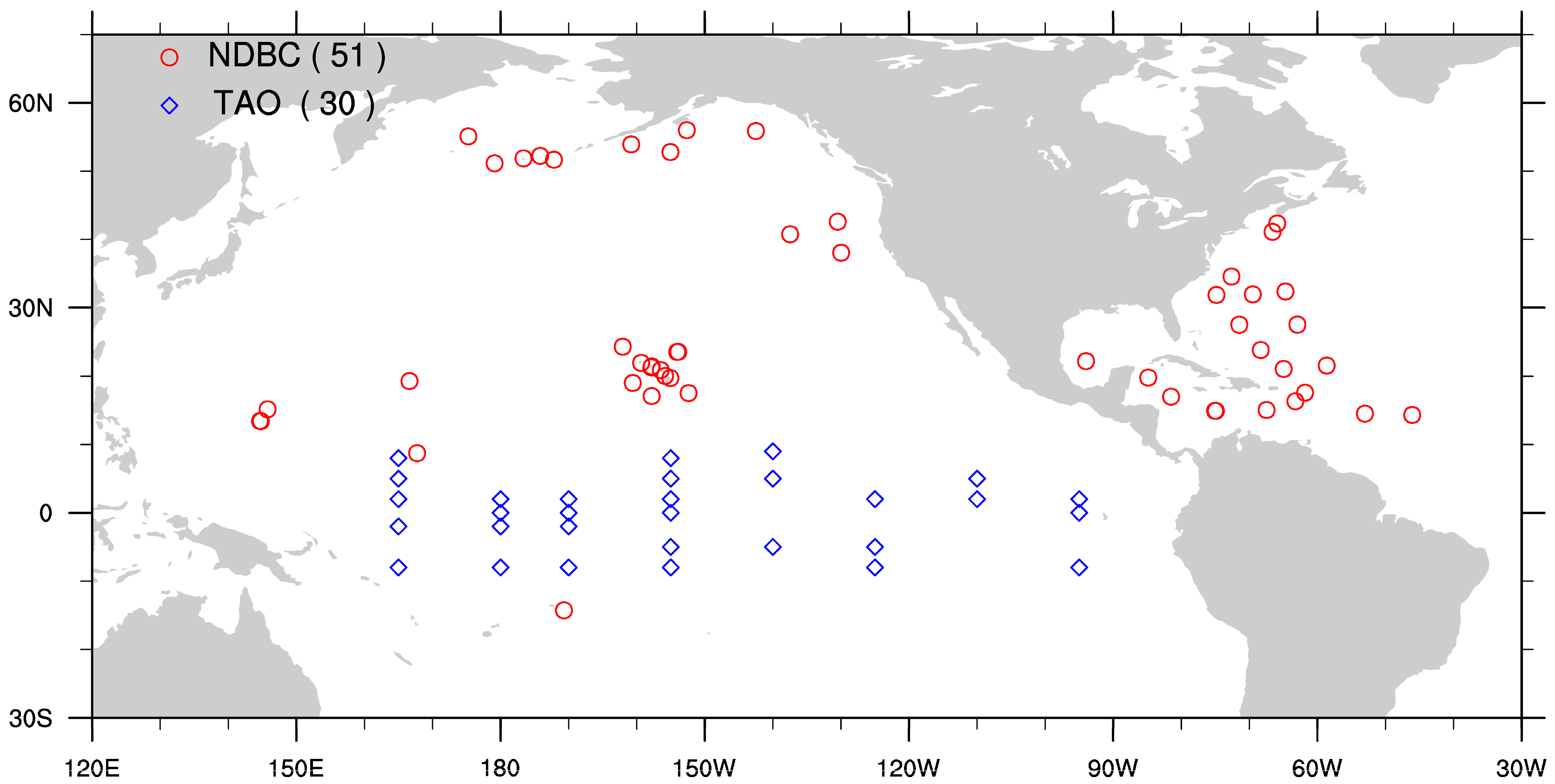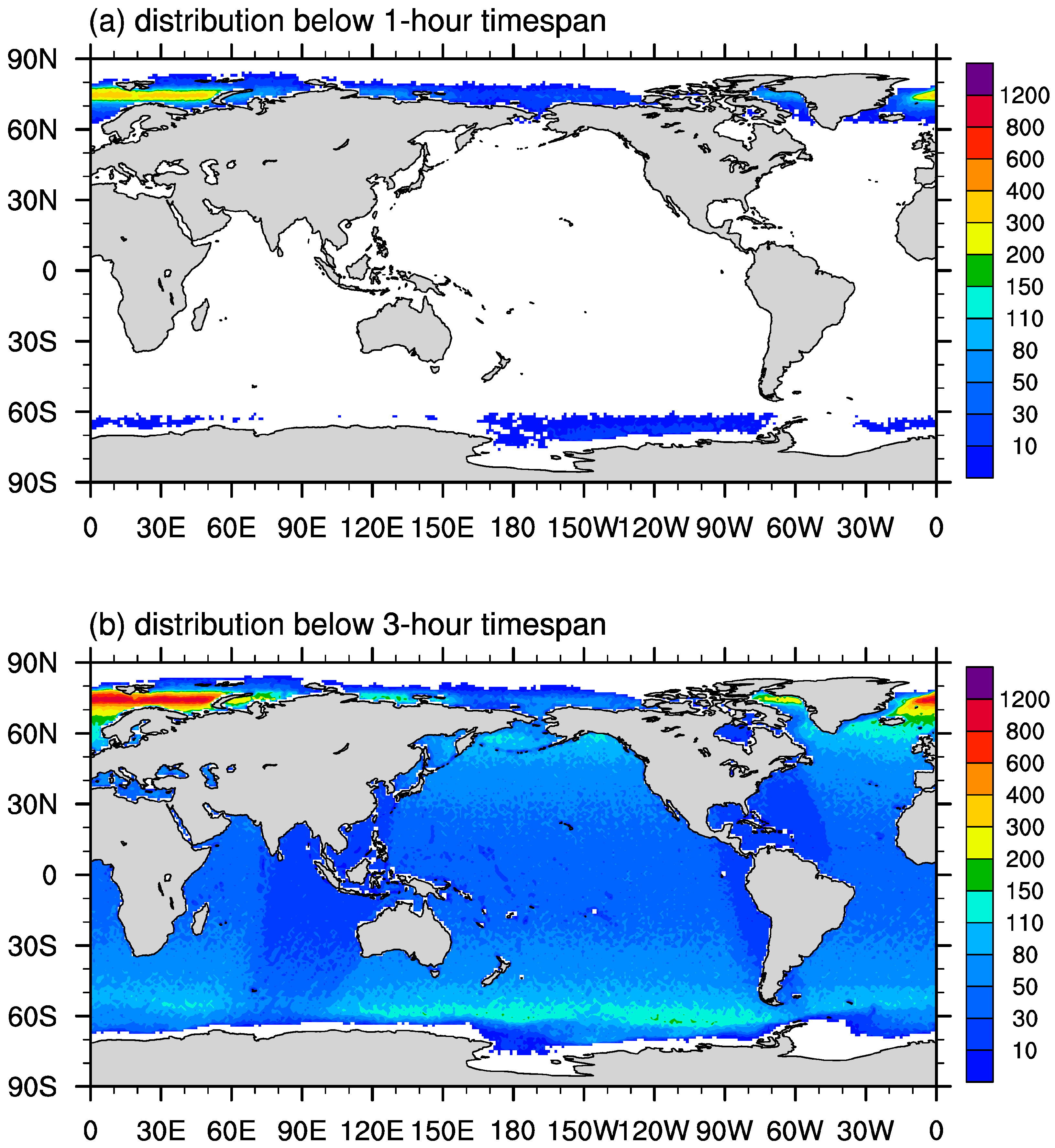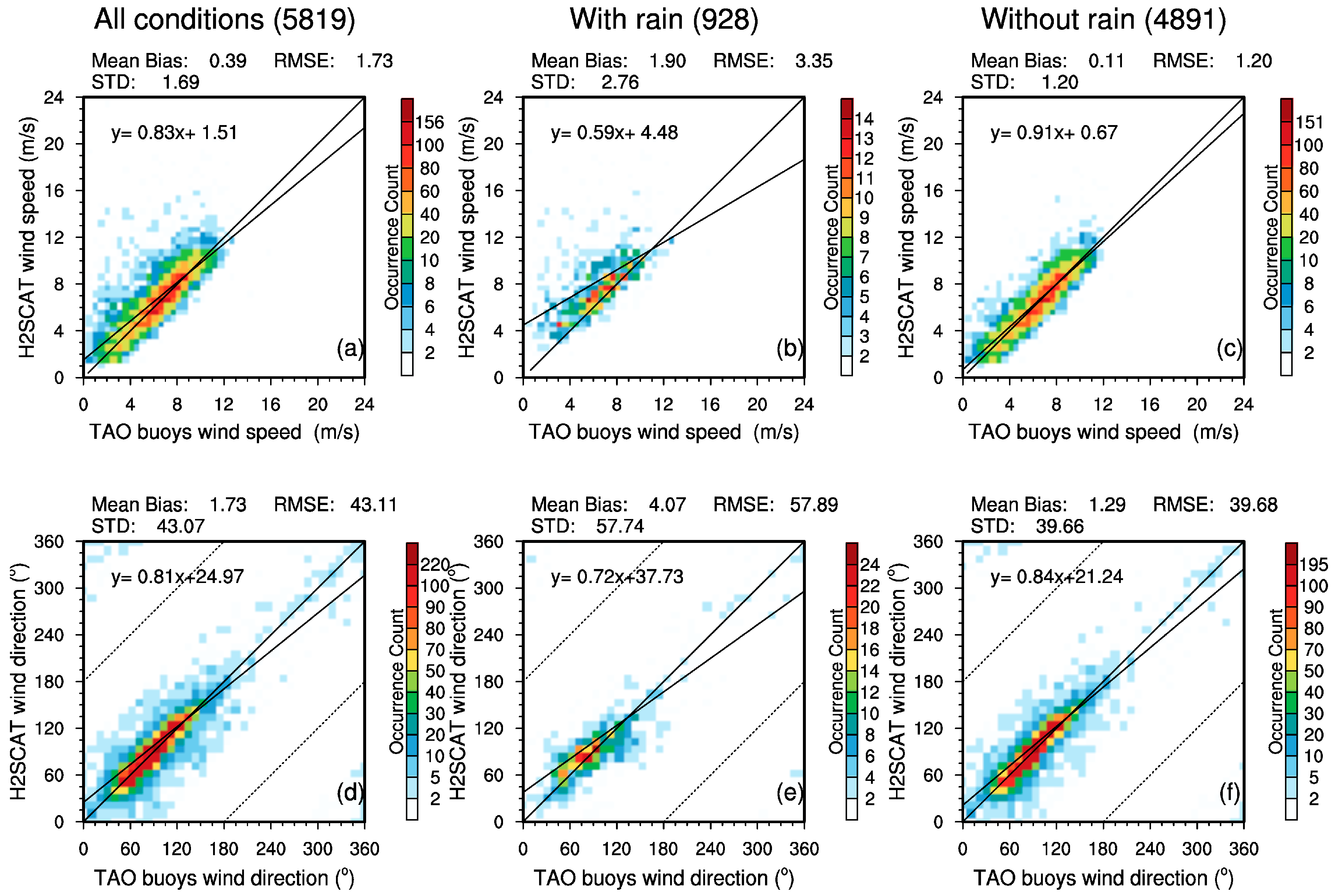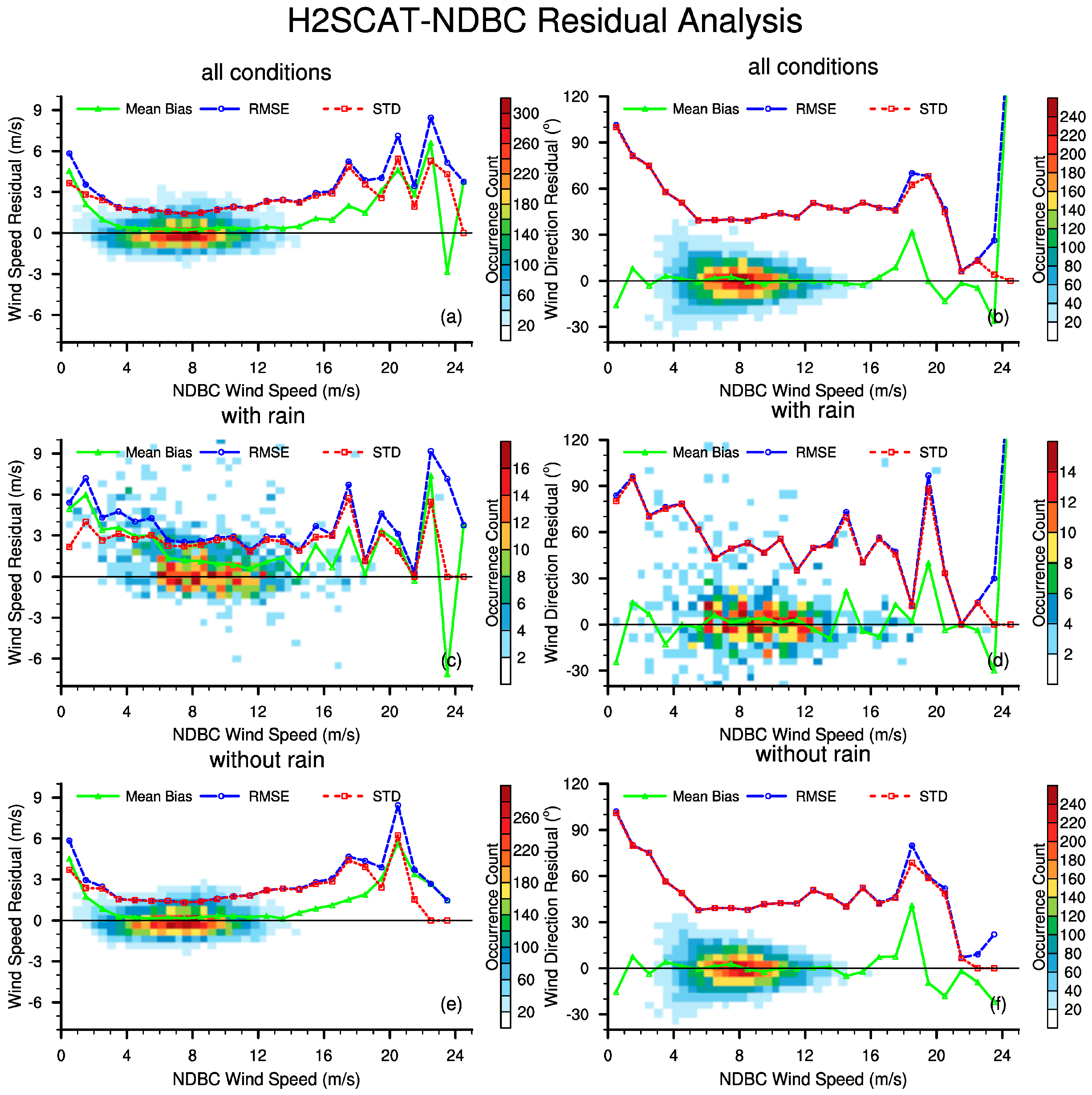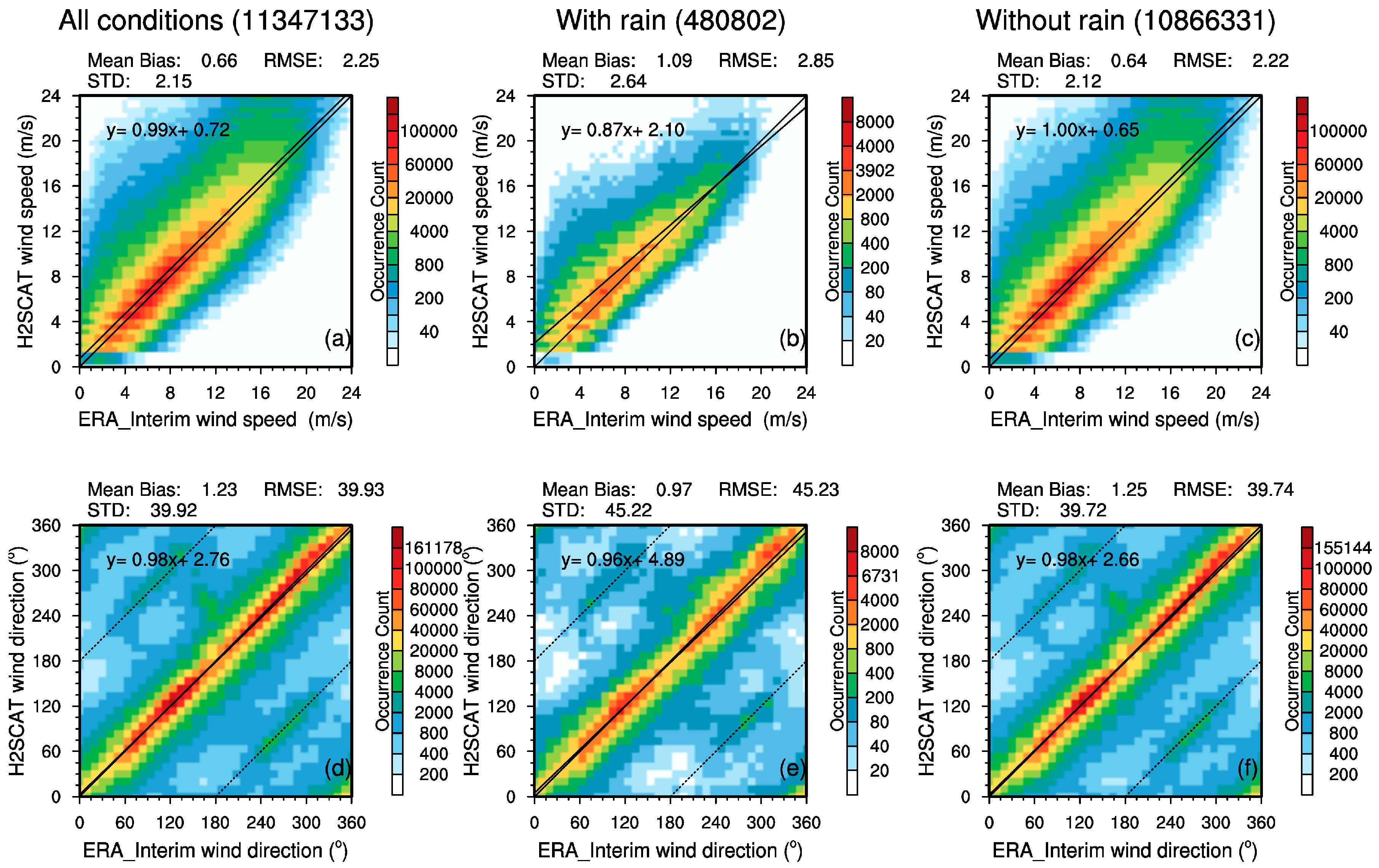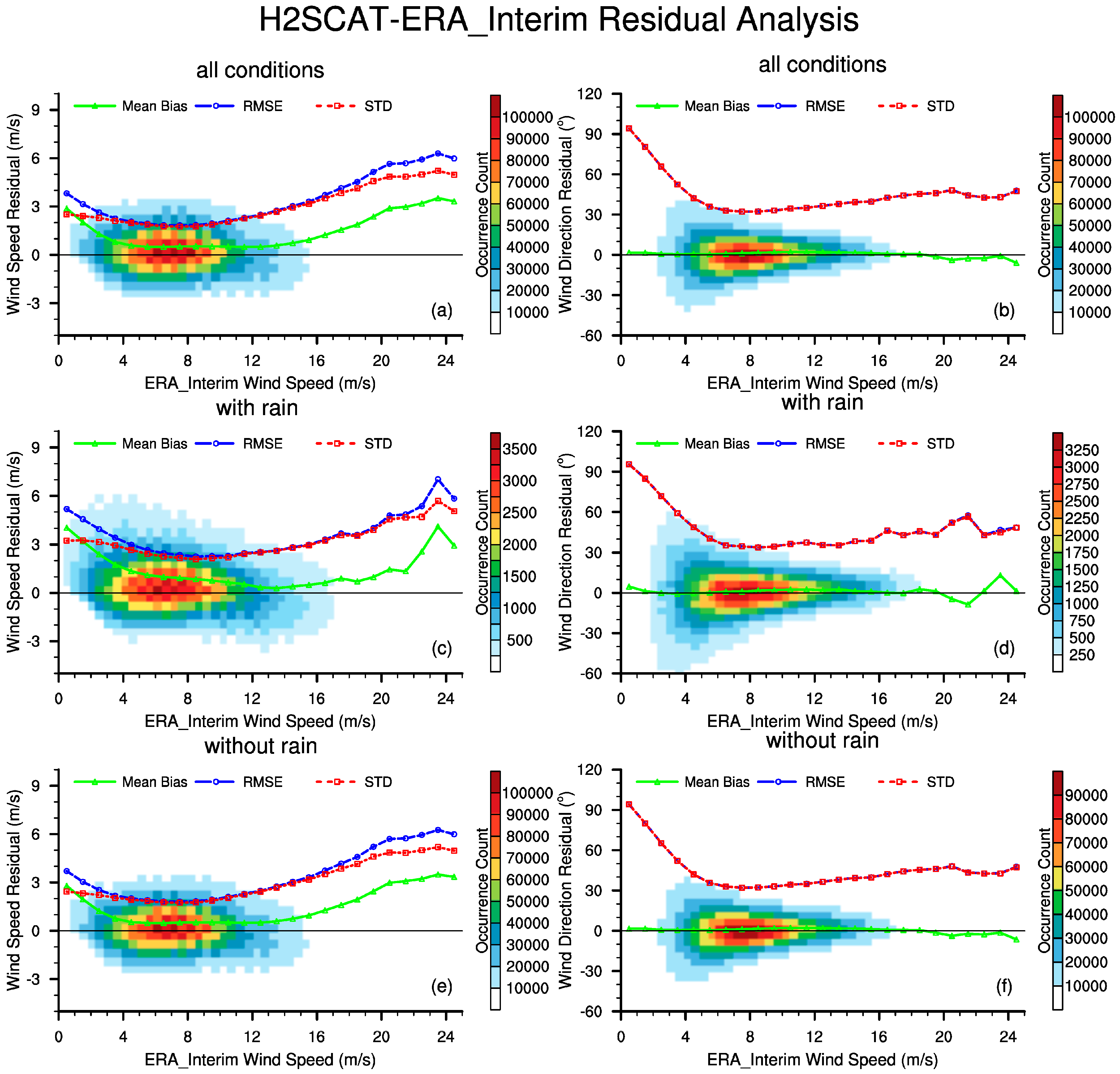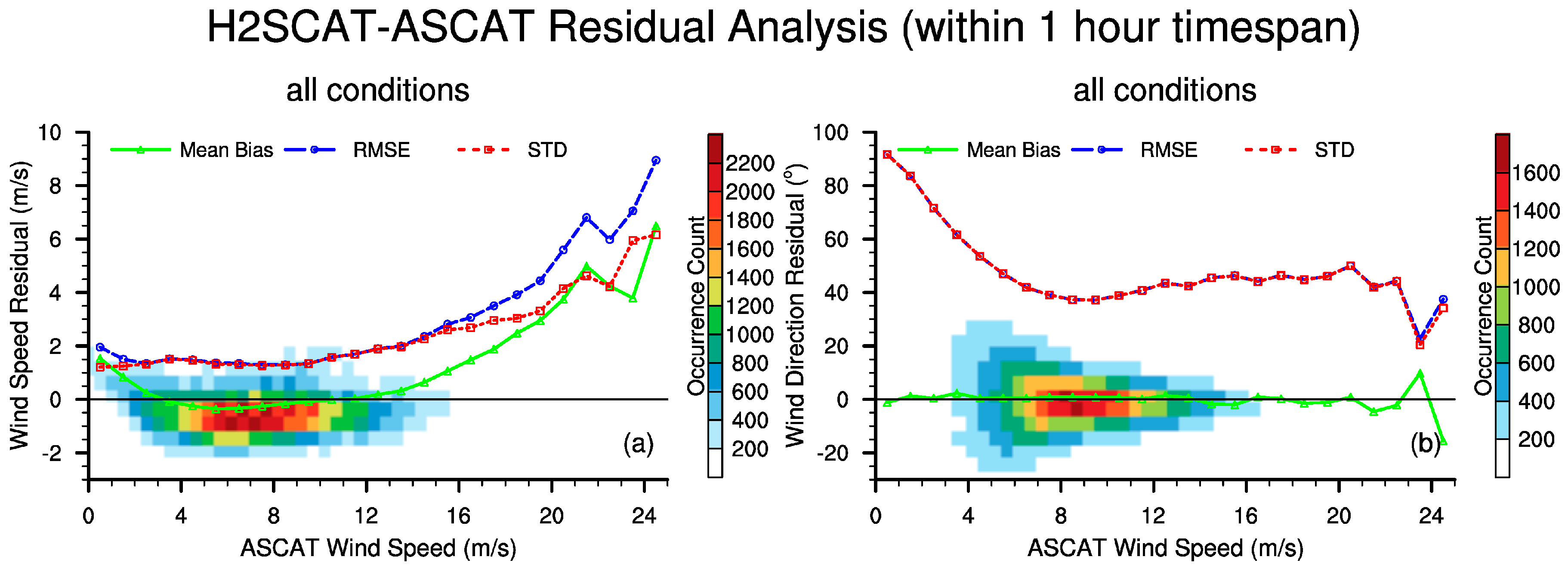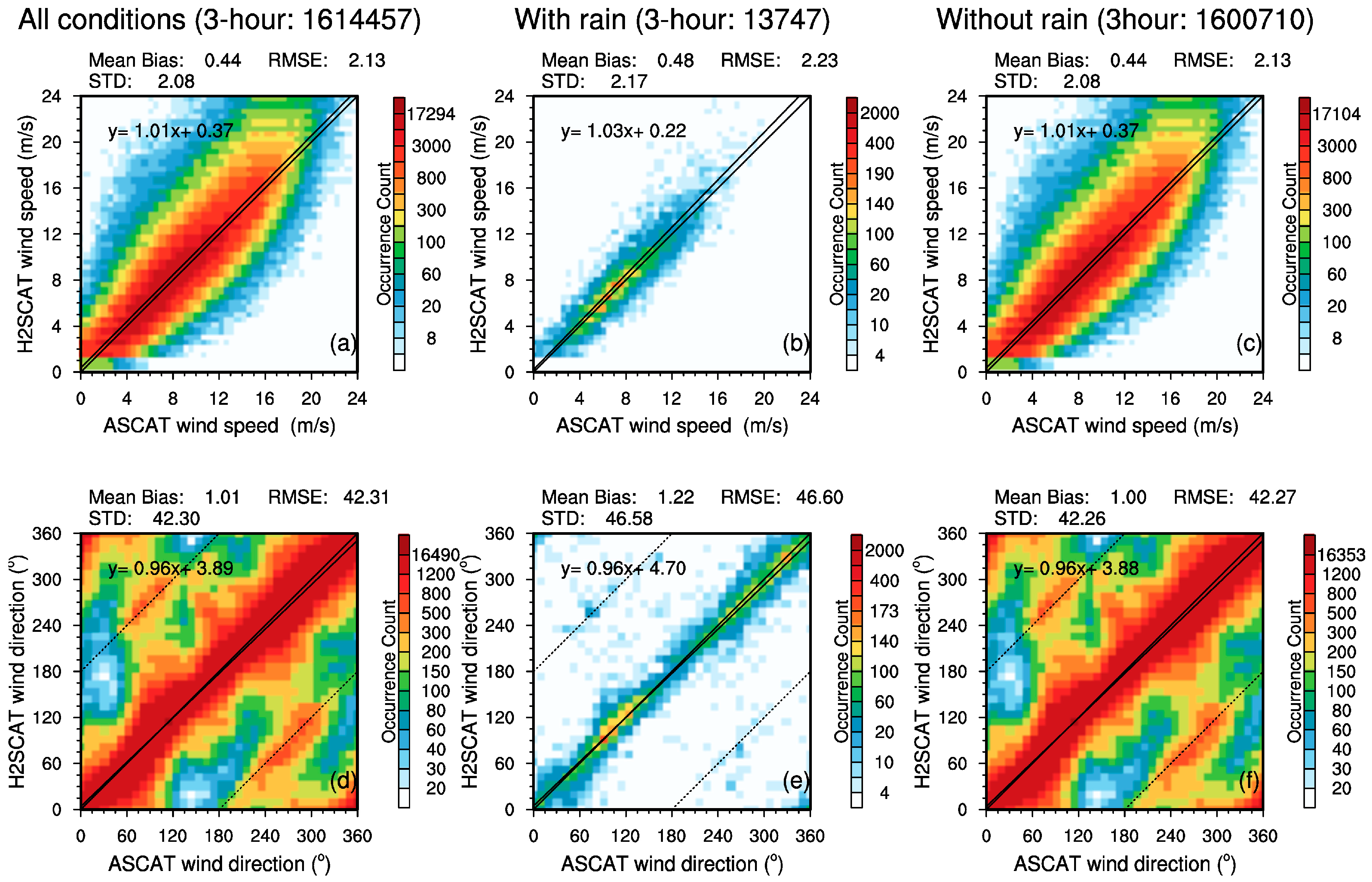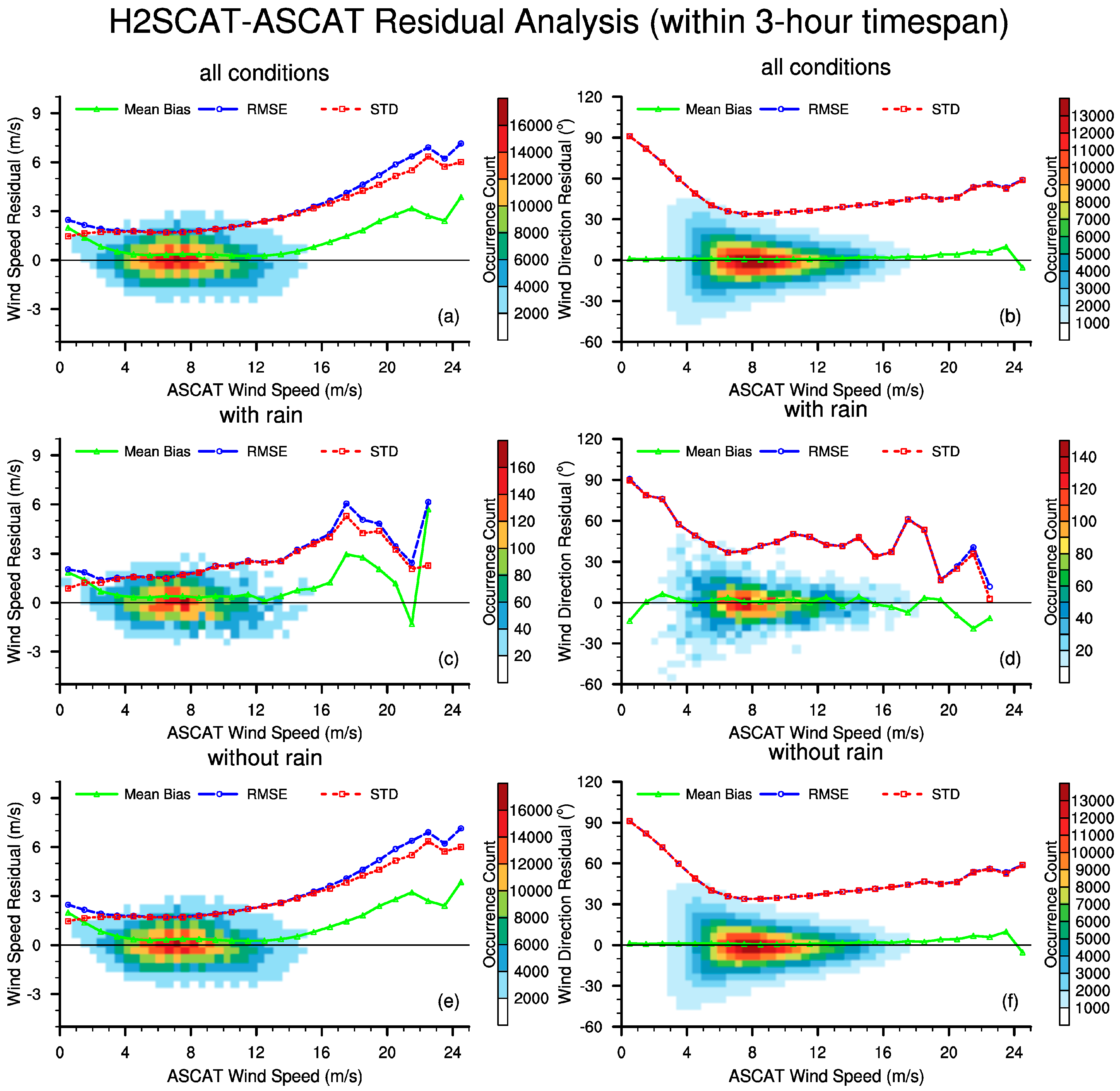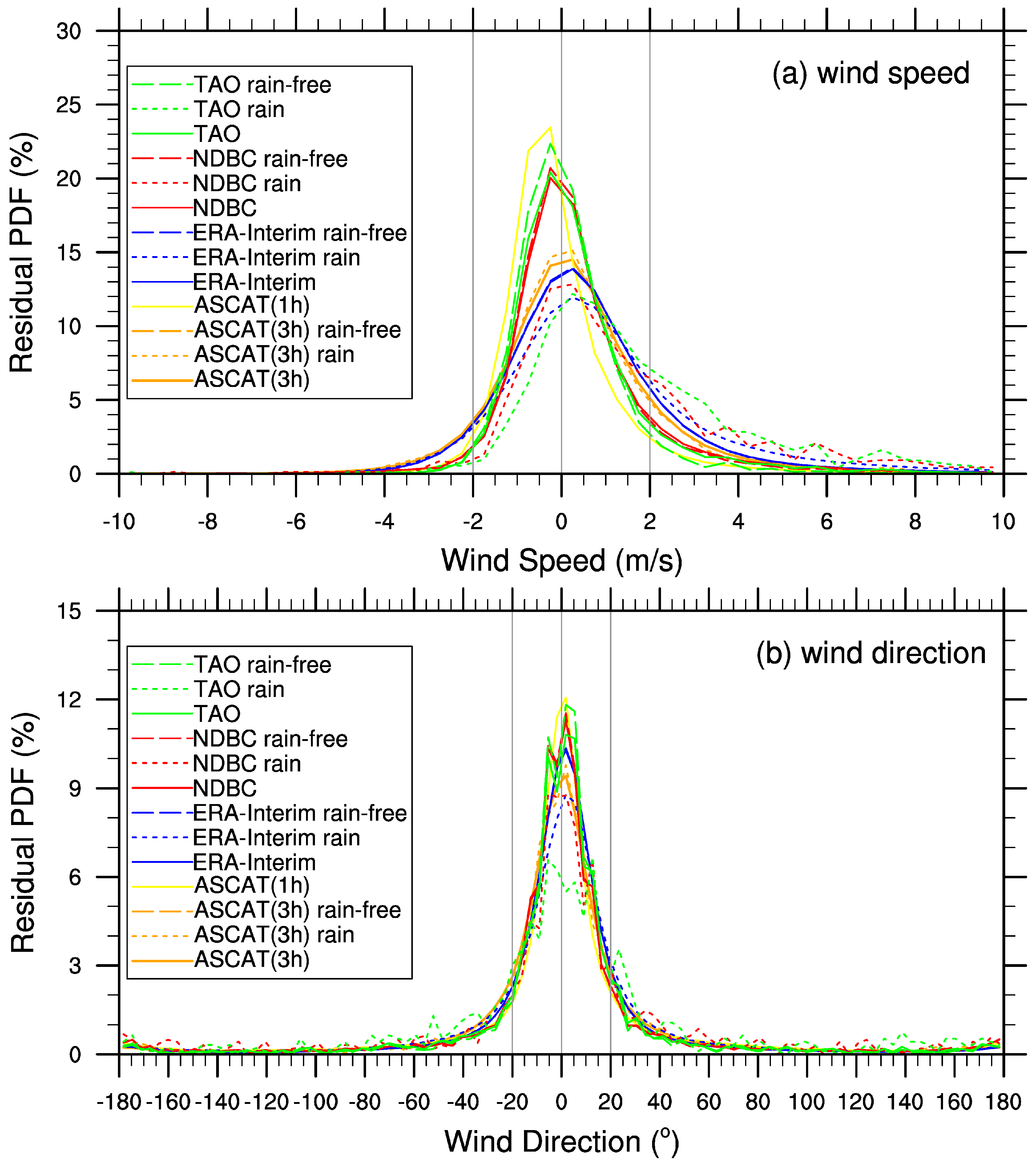1. Introduction
Ocean surface wind vectors play an important role in the development of sea waves, currents, and water mass activities. They also affect the evolution of sea surface temperatures, monsoons, ENSO (El Niño Southern Oscillation), and other phenomena. The wind vectors retrieved from the space-borne scatterometer have already been applied in many research fields [
1]. The satellite Haiyang-2A (HY-2A), launched in August 2011 [
2], monitors global ocean environment parameters such as sea-surface winds, ocean waves and currents [
3]. HY-2A is operated by China National Satellite Ocean Application Service (NSOAS) and carries four sensors: a microwave scatterometer (SCAT), a dual-frequency (Ku- and C-band) radar altimeter, a scanning microwave radiometer, and a three-frequency microwave radiometer [
2,
4].
The HY-2A SCAT (H2SCAT) is the first Chinese operational instrument since the first experimental SCAT launched in 2002 [
5]. Similar to the National Aeronautics and Space Administration (NASA) SeaWinds scatterometer on the Quick Scatterometer (QuikSCAT) satellite, which operates in the 13.4 GHz (Ku-band) [
6] and the scatterometer on the Indian Space Research Organisation (ISRO)’s satellite Oceansat-2 (OSCAT), which operates at 13.5 GHz (in the Ku-band) [
7], H2SCAT has a one-meter dish reflector antenna at a frequency of 13.256 GHz (also in the Ku-band). The QuikSCAT antenna ceased spinning in November 2009 [
8]. Moreover, the OSCAT failed in early 2014, leaving only three in-orbit operational scatterometers (H2SCAT and the advanced scatterometer (ASCAT-A and ASCAT-B) on board the meteorological operational (MetOp) series of satellites) [
9]. As the ASCATs operate at 5.255 GHz (C band), they are less sensitive to rain than the other scatterometers listed, which operate in the Ku band. [
10]. The two pencil beams of H2SCAT cover more than 90% of the global ocean in one day. The inner beam is HH polarized at incidence angle of 41° over a swath of 1350 km; the outer beam is VV polarized at incidence angle of 48° over a swath of 1700 km [
5,
11].
The evaluation of scatterometer wind retrievals is fundamental in data applications. After the launch of the QuikSCAT satellite in 1999 [
12], Ebuchi [
13] referenced the wind vectors observed by QuikSCAT/SeaWinds to the data from various buoys and found good agreement between the wind speeds and directions and the buoy data. In subsequent studies, the quality of the QuikSCAT winds was investigated in comparison to wind data from near-shore and moored buoys [
14,
15,
16], the results of numerical weather prediction (NWP) models [
17,
18,
19], and observations from ocean platforms and other scatterometers [
20,
21,
22]. The OSCAT [
7,
23,
24,
25] and ASCAT [
22,
26,
27,
28,
29,
30,
31,
32] data were also validated in several comparisons with the wind vectors from global ocean buoys, NWP and other scatterometers. Wang [
33] assessed the quality of H2SCAT wind products during the first six months (from January to June of 2012), using
in situ winds from the National Data Buoy Center (NDBC) buoys and several oil platforms. Yang [
34] compared the data from moored buoys and the European Centre for Medium Range Weather Forecasting (ECMWF) reanalysis data and preliminarily validated the accuracy of the H2SCAT wind retrievals over four months (the three-month period from January to March 2012, and August 2012). However, the H2SCAT products have yet to be evaluated over the designed lifetime of the satellite (January 2012 to December 2014). In this study, we gather three different types of wind data from oceanic moored buoys (NDBC and TAO), the ERA-Interim reanalysis and ASCAT, and collocate H2SCAT wind vectors with them. The aim was to evaluate the H2SCAT Level-2 near-real-time (NRT) during the entire 36 months from 2012 to 2014. The H2SCAT NRT product has been operationally received by the China National Marine Environmental Forecasting Centre (NMEFC). To improve and further apply the operational ocean forecasts, we comprehensively evaluate the quality of the HY-2A scatterometer winds.
In this study, we additionally consider the effect of rain on the scatterometer. As demonstrated in previous studies [
8,
35,
36,
37,
38,
39,
40,
41,
42], the effects of rain events cannot be ignored. The wind retrievals from returned signals use a geophysical model function (GMF), which empirically relates the wind vectors to radar observation of sea-surface [
8]. H2SCAT data are treated similarly [
5]. However, raindrops not only splash on the sea surface (magnifying the surface roughness) [
35] but also scatter or absorb the microwave radiation in the air while falling [
43]. In general, the splashing effect of rain is stronger which increases the measured radar backscatter, and affects the quality of the wind speed and wind direction retrievals [
36]. Lin [
44] shows that rainy areas also exhibit more wind variability, leading to larger differences between C-band scatterometer winds and buoy winds. There are no rain flags and other related rain information in the current version H2SCAT NRT Sea wind products. To investigate the effect of rain on the quality of the H2SCAT sea surface winds, we employ the National Oceanic and Atmospheric Administration (NOAA) Climate Prediction Center morphing method (CMORPH) rain data [
45]. The effect of rain on the wind speeds and directions derived from H2SCAT has not been discussed in previous studies.
3. Results
3.1. Comparison with TAO Moored Buoys
All of the TAO moored buoys are located near the equatorial Pacific. From January 2012 to December 2014, 5819 collocated pairs between the TAO buoys and H2SCAT were found. The 2-D histogram comparisons of the wind speeds and directions between TAO and H2SCAT under three conditions (all-weather, rain and rain-free) are presented in
Figure 3. The linear regressions in the 2-D histograms (regression coefficients 0.83 and 0.91 under all-weather and no-rain conditions, respectively) demonstrate the accuracy of the H2SCAT data, especially the wind speed. H2SCAT slightly overestimated the wind speed (by 0.39 m·s
−1) under the all-weather conditions. After the rain effect is rejected, the bias decreases to approximately 0.11 m·s
−1. The RMSE of the wind speed was 1.73 m·s
−1 overall, falling to 1.20 m·s
−1 after rain exclusion. Under rainy conditions, the H2SCAT overestimated the wind speed by 1.90 m·s
−1 and the RMSE increased to 3.35 m·s
−1. Correspondingly, the linear regression coefficient reduced to 0.59 with a larger intercept of 4.48 m·s
−1.
The linear regression coefficients of the wind directions between H2SCAT and TAO are about 0.8. H2SCAT shows a slightly positive bias ~1.73°, reducing to 1.29° under rain-free conditions. Under all-weather conditions, most of the H2SCAT wind directions were in good agreement with the TAO buoys, and the overall RMSE was 43.11°. The RMSE increased to 57.89° under rainy conditions, and reduced to 39.68° without rain. Under rainy conditions, the linear regression coefficient of the wind direction between H2SCAT and TAO reduced to 0.72 with an intercept of 37.73°. In general, rain increases the uncertainty in both the speed and direction of wind. The effects of rain on wind vector retrievals are obvious and consistent with those of the SeaWinds scatterometer [
38].
The wind speed and wind direction residuals (H2SCAT-TAO) under all-weather, rain and rain-free conditions, are presented in
Figure 4. The residual are calculated for 1 m·s
−1 bins of the TAO buoy wind speeds.
Table 1 summarizes the statistical parameters of the wind speeds and directions between the H2SCAT and TAO buoys. Results are shown for the low, moderate, and high wind speed ranges under all-weather, rain, and no-rain conditions. Under all-weather conditions and moderate wind speeds (4–13 m·s
−1, which includes more than 86% of the collocated data), the bias in the wind speed was nearly zero and the STD was below 2 m·s
−1. At low wind speeds (<4 m·s
−1, which includes less than 13% of the collocated data), the bias was positive and varied from 3.5 to 1 m·s
−1. Correspondingly, the STD varied from 3.5 to 2.0 m·s
−1. Only 93 pairs of collocated data were found in the high speed range (>13 m·s
−1), and the bias in this range was large and irregular. The wind direction shows no obvious bias at all wind speeds. The bias was irregular at low and high wind speeds. The STD decreased from ~100° in the low wind-speed range to ~30° in the moderate wind-speed range (<7 m·s
−1), and increased again to 60° at high wind speeds.
The precipitation more severely affected the H2SCAT data at low wind speeds than at high wind speeds. In most cases, the wind speed was overestimated under rainy conditions. The positive bias at low wind speed (<4 m·s
−1) reached as high as 3–6 m·s
−1. Similar effects of rain were reported for QuikSCAT winds [
37]. Under rain-free conditions, the H2SCAT wind speed better matched the buoy wind speed in most ranges. The STDs of the wind speed were below 1.5 m·s
−1, and the biases were generally negligibly small. Precipitation always worsened the wind direction products of H2SCAT, especially in the moderate wind speed range (4–10 m·s
−1).
3.2. Comparison with NDBC Moored Buoys
Most of the NDBC buoys used in this study lie in the Mid-latitude Ocean. In the three-year observation period, 20,867 pairs of wind vectors were collocated between H2SCAT and the NDBC buoys.
Figure 5 presents the 2-D histograms of wind speeds and directions between the H2SCAT and NDBC buoys under different conditions. Under the all-weather conditions, the H2SCAT wind speeds were consistently overestimated relative to the NDBC. The mean biases in the wind speed were 0.44 m s
−1 for all collocated data and 0.34 m·s
−1 without rain, but increased to approximately 1.58 m s
−1 under rainy conditions. The RMSE was 1.78 m·s
−1 without rain, increasing to 3.29 m·s
−1 under the rain effect. The overall average RMSE is 1.94 m·s
−1. The linear regression coefficient is 0.98 and 0.99 under all-weather and rain-free conditions, which also implies that the wind speed of H2SCAT agrees well with NDBC. Most of the points in the wind direction plots gather near the 1-to-1 slope. The wind directions of H2SCAT are slightly positive bias (0.56°) under all-weather conditions. The bias drops to 0.46° under rain-free. Overall, the average RMSE was about 46.63°, increasing to 55.39° and falling to 45.78° in the rainy and rain-free cases, respectively.
Figure 6 plots the residuals (H2SCAT-NDBC) of the two components of all collocated wind vectors under all-weather, rain and rain-free conditions.
Table 2 summarizes the statistical parameters between the H2SCAT and NDBC buoys under all-weather, rain and no-rain conditions. Again, the results are separated into three ranges of wind speeds (low, moderate, and high). The H2SCAT wind speeds were consistently overestimated. The positive bias reached as high as 4–7 m·s
−1 especially at low (<4 m·s
−1) and high (>13 m·s
−1) wind speeds. The STD of the wind speed was 1.65 m·s
−1 in the moderate wind speed range (4–13 m·s
−1, which includes more than 90% wind data). At low (<4 m·s
−1) and high (>13 m·s
−1) wind speeds, the STD was approximately 2–3 m·s
−1 and up to 7 m·s
−1, respectively. The wind direction exhibited almost no bias and the STD was about 42° at moderate wind speeds (4–13 m·s
−1). At low and high wind speeds, the STD is large, up to 100°.
Under rainy conditions, the bias in the H2SCAT wind speed increases to 6 m·s−1, while the STD reached about 4 m·s−1. The increases were especially marked at low and high wind speeds. At moderate wind speeds (4–13 m·s−1) in rain-free conditions, the wind speed bias almost vanished and the STD fell to below 1.5 m·s−1. The bias and STD of wind speed were both highly reduced at low wind speeds (<4 m·s−1), but were slightly improved at high wind speeds (>13 m·s−1). Regarding the wind direction, the bias in rain-free condition was almost zero, but was slightly increased under rainy conditions in all speed range. The STD of the wind direction was relatively insensitive to rain, except at some low and moderate wind speeds. The STD of wind direction reached ~100° at low wind speeds (<4 m·s−1), regardless of rain. The STDs were more variable under rainy conditions than under rain-free conditions are high wind speed (>13 m·s−1).
3.3. Comparison with ERA-Interim Reanalysis
For each collocated pair, the U and V components of ERA-Interim reanalysis were converted to wind speeds and directions. The collocated data pairs for comparison numbered 11,347,133 over the three years, including 480,802 (4.24%) under rainy conditions and 10,866,331 (95.76%) under rain-free conditions.
Figure 7 plots the 2-D histograms of the wind speeds and directions between H2SCAT and ERA-Interim. The H2SCAT shows higher accuracy against the ERA-Interim data than under the buoy data in
Figure 3 and
Figure 5. The linear regression coefficients, particularly for the wind speeds, are as high as 0.99 under the all-weather condition and 1.0 without rain, although systematic biases appear. The overall mean bias of the wind speed was approximately 0.66 m·s
−1, reducing to 0.64 m·s
−1 without rain. Accordingly, the RMSE reduces from 2.25 under all-weather conditions to 2.22 m·s
−1 under rain-free condition, and the STD dropped from 2.15 to 2.12 m·s
−1. The error statistics were higher under rainy conditions. The mean bias, RMSE, and STD in the wind speed were 1.09, 2.85, and 2.64 m·s
−1, respectively. The mean bias in the wind direction was approximately 1.23° under all-weather conditions, improving to 0.97° under rainy conditions and slightly worsening to 1.25° under rain-free conditions. The RMSE and STD of all collocated pairs approximated 39.93°, slightly reducing to 39.74° under rain-free conditions, and rising to 45.23° with rain.
Figure 8 plots the residuals (H2SCAT-ERA-Interim) under the all-weather, rain and rain-free conditions. The residuals of all collocated pairs are similar to those under rain-free conditions.
Table 3 summarizes the statistical parameters of wind speed and direction between H2SCAT and ERA-Interim reanalysis under the all-weather, rain and no-rain conditions. The wind speed biases were about 0.5 m·s
−1 in the moderate speed range (4–13 m·s
−1), where more than 90% of the data are located. The biases enlarged to 2.7–3 m·s
−1 at lower (<4 m·s
−1) and higher (>13 m·s
−1) wind speeds. The STD decreased from 2.5 to 1.8 m·s
−1 as the wind speed increased from 0 to 6 m·s
−1, but increased to more than 4.0 m·s
−1 at high wind speeds (>13 m·s
−1). The wind direction shows almost no mean bias. The STD was below 40° at moderate wind speeds (4–13 m·s
−1) and slightly increased at high wind speed (>13 m·s
−1). The STD reached as large as 90° at low speed range (<4 m·s
−1).
Under rainy conditions, the mean biases in the wind speed were amplified to approximately 1 m·s−1 at moderate speeds (4–13 m·s−1) and to 2–4 m·s−1 at low wind speeds (<4 m·s−1). The STD was around 2 m·s−1 at moderate speeds (4–13 m·s−1), but exceeded 3 and 5 m·s−1 at low and high wind speeds, respectively. Under the no-rain condition, the mean biases and STDs were small and similar to those under the all-weather condition. This result is attributed to the greater number of occurrences of rain-free pairs than the rainy pairs. The mean bias in the wind direction was very similar in the rainy and rain-free conditions, except for some irregular fluctuations at high speed under rainy conditions. Precipitation slightly degraded the STD of the wind direction at low (<4 m·s−1) and high wind speeds (>13 m·s−1).
3.4. Comparison with ASCAT Retrieved Wind Vectors
Figure 9 presents the 2-D histograms of wind speed and direction between ASCAT and H2SCAT within 1-h timespan. The H2SCAT show higher accuracy against the ASCAT data than under the buoy data in
Figure 3 and
Figure 5. The linear regression coefficients are as high as 1.05 for the wind speeds and 0.81 for directions. The wind speeds of both scatterometer data are consistent. The mean bias of the wind speed is almost zero, and the RMSE and STD both equal 1.62 m·s
−1. However, the wind directions differ between the two datasets. Although the mean bias is small (0.68°), the RMSE and STD are relatively high (47.5°).
The residual analysis is shown in
Figure 10.
Table 4 summarizes the statistical parameters of wind speeds and directions between H2SCAT and ASCAT within 1-h timespan. At low (<4 m·s
−1) and moderate wind speeds (4–13 m·s
−1), the wind speed bias almost vanished and the STD was below 2 m·s
−1. In contrast, at high wind speeds (>13 m·s
−1), the bias dramatically increased to more than 5 m·s
−1, and the STD was amplified up to 6 m·s
−1. These results are probably due to the obvious underestimation of ASCAT at wind speed exceeding 20 m·s
−1 [
32]. The wind direction was negligibly biased by less than 2°, but the STD was increased to 50°–90° at low wind speeds (<4 m·s
−1). At moderate (4–13 m·s
−1) and high wind speeds (>13 m·s
−1), the bias was close to 0°, whereas the STD was around 43°.
In order to check the difference between the two SCATs beyond the Polar zone, we use the 3-h collocations and discard the pairs located outside of 60°S–60°N.
Figure 11 presents the 2-D histograms of wind speed and direction between ASCAT and H2SCAT within 3-h timespan. Unlike the comparison of 1-h timespan, the wind speed mean bias and RMSE increased to 0.44 and 2.13 m·s
−1 under all conditions, however, the wind direction decreased to 42.31°. The degradation of wind speed was probably due to the expanded time interval, and the improved wind direction was caused by geographical position change. Under rain conditions, the mean bias and RMSE of wind speed and direction increased a little from 0.44 and 2.13 m·s
−1 to 0.48 and 2.23 m·s
−1 and from 1.01 and 42.31° to 1.22° and 46.6° respectively. The performance under rain-free are similar with all conditions, because of the number of collocations without rain is far more than with rain.
Figure 12 shows the residuals (H2SCAT-ASCAT within 3-h timespan) under the all-weather, rain and rain-free conditions.
Table 5 summarizes the statistical parameters of wind speed and direction between H2SCAT and ASCAT within 3-h timespan under the all-weather, rain and no-rain conditions. Most of the collocated pairs (>77%) were in the moderate speed range (4–13 m·s
−1), where the wind speed biases and RMSEs were about 0.3 and 1.9 m·s
−1, and the wind direction biases and RMSEs were about 0.8° and 37°. At low speeds, the mean biases and RMSEs increased slightly to 0.9 and 2.0 m·s
−1 for wind speed; but for wind direction, the RMSEs were up to 90°. In the high wind speed range, the wind direction STDs were about 40°–50°, while the wind speed STDs were higher as 3.0–7.0 m·s
−1.
Under rainy conditions, the wind speed mean biases, STDs and RMSEs had not significantly changed in the moderate and low speed range (0–13 m·s−1), but resulted in some instable features at high wind speeds. For wind direction, the rain brought some irregular fluctuations for bias, especially at low and high speeds. Because of the considerable numbers of rain-free collocated pairs compared to rain conditions, the results of rain-free conditions were highly similar with all conditions.
3.5. Residual PDF Analysis of Different Data
To investigate the distribution of the bias between the H2SCAT wind vectors and other observations, we plot the residual probability distribution functions (PDFs) of wind speeds and directions in
Figure 13. The vertical lines at 2 m·s
−1 and 20° highlight the designed precisions of the wind speed and direction in H2SCAT, respectively [
2].
Table 6 summarizes the proportion of the wind speed and direction residuals within the designed precision. The wind speed residual distribution is approximately normal. ASCAT (1-h) shows the best performance, with a sharp peak reaching 23% near the zero line (0 m·s
−1) and 91% of the distribution within the ±2.0 m·s
−1 range. The PDF of the NDBC is approximately 20% near zero line at no-rain condition, reducing sharply to below 12% at rainy conditions. Meanwhile, the residual proportion between ±2.0 m·s
−1 was degraded from 93.3% to 63.6%. The tightest distribution was exhibited by TAO, with 93.3% of the distribution in the ±2.0 m·s
−1 range under rain-free conditions. Precipitation degraded the wind speed PDF of TAO to only 61.9% in the valid range.
Precipitation exerted similar effects on the wind direction. Under rain condition, only 55.1%, 61.4%, and 65.8% of TAO, NCBC, and ERA-Interim distributions are located in the ±20° range. In total, 69%–73% of the collocated data pairs in different comparisons are located within the designed precision range of wind direction.
4. Discussion
The retrieved wind vectors from H2SCAT were fully evaluated on various original datasets during the designed lifetime of the satellite (2012–2014).
Table 7 lists the RMSEs of the wind speed and direction at seven levels (here, 2–24 m·s
−1 is the designed valid range of the wind speed [
2]). The corresponding Beaufort wind scales are also shown.
The retrieved wind data are most favorably compared with the NDBC and TAO buoy observations. From 19 July 1999 to 31 December 2000, the RMSEs of QuikSCAT wind speeds and directions (relative to ocean buoys over the Pacific and Atlantic Oceans) were 1.01 m·s
−1 and 23°, respectively [
13]. In that evaluation, all of the flagged data (rain flagged, low wind speed flagged, and high wind speeds flagged) were excluded. In another near-shore study, the performance of QuikSCAT was even worse when data flagged for rain and light wind speeds (<3 m·s
−1) were excluded (the RMSEs of wind speed and direction were 1.4 m·s
−1 and 37°, respectively) [
14]. During 1 November–21 November 2009, the RMSEs of the wind speeds from QuikSCAT and OSCAT were 1.69 and 1.76 m·s
−1, respectively (relative to buoy data), while the respective wind direction counterparts were 34.67° and 24.69° [
24]. In comparisons of the QuikSCAT wind data with buoys observations from the Indian Ocean, the RMSEs of the wind speed and direction were 1.57 m·s
−1 and 44.1°, respectively [
16]. In the Black Sea, the RMSEs of the wind direction relative to buoy observations varies from 31.8° to 56.6°, depending on month [
20]. In the Ligurian Sea, the RMSEs of wind speed and direction were 1.97 m·s
−1 and 79.5°, respectively, under rain-free condition [
54]. These studies indicate that the accuracy of the QuikSCAT wind vectors depends on different factors, such as periods, oceans and weather situations.
When compared with buoy data from the Pacific Ocean under no-rain conditions, the H2SCAT wind speed data performed similarly to QuikSCAT, but differed in the wind direction performance. The RMSE of wind speed and direction were 1.2–1.8 m·s
−1 and 40°–45.7°, respectively. These results are consistent with the previous study, in which the RMSE of wind speed and direction from a four-month H2SCAT dataset were reported as 2.02 m·s
−1 and 40.28°, respectively [
34].
Although ocean buoy observations are widely applied in evaluations of scatterometers, and in quality adjustments and improvements of satellites, for the limitation of buoys, which are restricted to the Tropics and the coast of North America, the scatterometer data must be evaluated over the global scale using reanalysis data. In a comparison study of ECMWF and NCEP analysis data with QuikSCAT (2000 and 2002) and NSCAT (1997), QuikSCAT was found to outperform NSCAT [
17]. The RMSE was 1.5–2 m·s
−1 at low latitudes, increasing to more than 3 m·s
−1 in mid and high latitudes. The RMSE of H2SCAT wind speed in the present study (relative to ERA-Interim) was 2.25 m·s
−1 across the globe, slightly higher than in QuikSCAT. In the statistics comparisons, the improved performance of H2SCAT with TAO than with NDBC might be attributable to geographical differences. The TAO buoys are close to the equator but the NDBC buoys are at higher latitudes and mostly in the Northern Hemisphere. The RMSE of the wind direction (~40°) is consistent with Yang [
34], who also adopted ERA-Interim data for comparison.
The quality of a new sensor may also be evaluated in scatterometer comparison. Collocated with ASCAT wind vectors, the H2SCAT data were located either below 50° S or above 50° N within 1-h timespan, where the RMSEs of the wind speeds and directions are 1.62 m·s
−1 and 47.47°, respectively. The RMSEs were changed to 2.13 m·s
−1 and 42.31° when the time span was expanded to 3 h. Likewise, within a half-hour timespan in the polar zone (<55°S and >50°N), the proportion of collocated data between OSCAT and ASCAT is only 1.15%, and the RMSEs of the wind speed and direction were 1.47 m·s
−1 and 26°, respectively [
24]. On the other hand, collocations of QuikSCAT and ASCAT are found in the polar zone within 1-h timespan, and the STD between two scatterometers was approximately 1.5–2 m·s
−1 [
22].
H2SCAT always overestimates at low and high wind speeds, regardless of counterpart data used in the comparison. Previous studies similarly reported that QuikSCAT or other Ku-band scatterometers overestimate at low and high wind speeds [
13,
15,
16,
54]. The Ku-band is more sensitive to wind variation at low winds than C-band, because short ocean surface waves have stronger influence on backscatter at high frequencies at low wind speeds [
1]. The overestimation of H2SCAT implied a defect of the GMF in HY-2A wind inversion. At high wind speed, the retrieval model functions are limited by the relationship between the wind speed and the backscattered power [
55]. For wind direction, the joint histograms (see
Figure 3,
Figure 5,
Figure 7,
Figure 9 and
Figure 11) show that there are some clusters around 180° off, which is due to an imperfect ambiguity selection process. Regarding the wind direction at low wind speeds, H2SCAT (similar to QuikSCAT) showed a decentralized distribution in the residual analysis, which is attributed to the incompleteness of the ambiguity removal algorithm using the median filter technique [
34], together with errors in the geophysical model at low wind speeds [
13]. Many factors including rain, increased local wind variability, confused sea state (waves), and land/ice contamination might induce poor quality of wind retrievals [
44]. The H2SCAT showed its strongest performance at moderate speeds, especially in range 4–10.8 m·s
−1 range (see
Table 6).
Scatterometer wind retrievals tend to be contaminated by rain effects [
1,
35,
38]. In this study, we evaluated the effects of rain on H2SCAT by employing CMORPH data and found overestimates of the H2SCAT wind speed under rainy conditions. The positive bias caused by rain is much higher at low wind speeds (~2–5 m·s
−1) than at moderate and high wind speeds. Stiles and Yueh analyzed one year of QuikSCAT and SSM/I data and found that even light rain produces a higher backscatter than low-speed wind [
37]. They also reported that at high wind speeds, rain does not significantly corrupt the measurement of wind-induced surface backscatter. Portabella and Stoffelen also reported higher rain sensitivity at low winds than at moderate and high winds [
36]. In summary, the impact of rain on the wind speed retrievals decreases with increasing wind speed.
Information on wind direction is considered to be available in much of the rain-contaminated data [
37]. Weissman [
8] proposed that the azimuth variation in the wind-induced backscatter can still be detected and is useful for estimating the wind direction (provided that the rain attenuation is only moderately large). According to the residual analyses of different collocated data in the present study, the STDs and RMSEs of the wind direction in H2SCAT are slightly higher under rain conditions than under rain-free conditions, especially at low and moderate wind speeds.
Although several studies noted the rain effects on scatterometer wind data, and attempts to reduce these effects are numerous [
8], the nonlinear relationship between the rain effects (attenuation and roughening) and wind retrieval model functions are difficult to elucidate. The effects of different rain rates on the wind retrieval ability of H2SCAT must be investigated in further study.
5. Conclusions
This study comprehensively verified the three-year (2012–2014) NRT Level-2 retrieval wind vectors from the scatterometer onboard the HY-2A satellite, the first Chinese operational ocean environmental dynamic satellite. Winds from four data sources (TAO and NDBC buoys, ERA-Interim reanalysis, and ASCAT) were employed in comparison studies. To investigate the influence of rain on the wind retrieval accuracy, we also collected rain data from the Climate Prediction Center morphing method (CMORPH) [
45]. Data pairs between the HY-2A scatterometer wind retrievals and the comparison observations were collocated and evaluated by statistical variables (the mean bias, root mean square error, and standard deviation). The residual analyses of the wind speeds and directions in the different data comparisons were also presented, and the rain effects on the retrieval wind vectors were discussed. Finally, the residual probability distribution functions (PDFs) of the wind speeds and directions were computed for all comparisons.
Overall, the quality of the wind vectors of the HY-2A scatterometer (especially the wind speeds) favorably compared with those of other Ku-band scatterometers such as QuikSCAT. The RMSEs of the wind speeds and directions varied from 1.62 m·s−1 to 2.25 m·s−1 and from 39.23° to 47.47°, respectively, depending on the comparison. Low and high wind speeds were always overestimated; however, the vast majority of wind is at moderate speeds. At low wind speeds, the STD increased more rapidly in the wind direction than in the wind speed. On the contrary, at high wind speeds, the STD reduced more rapidly in the wind speed than in the wind direction. At moderate wind speeds (4.0–10.8 m·s−1), there were almost no biases in wind speed and direction. The RMSE reduced to 1.10–1.90 m·s−1 (in wind speed) and 32.32°–40.79° (in wind direction), depending on the comparison.
Rain exerted significant and robust effects on the wind retrievals from the HY-2A scatterometer. Positive biases in the wind speed, especially at low wind speeds, are attributed to attenuation of backscatter in the air and the increased surface roughness of the sea under falling raindrops. As the wind speed increased, rain exerted a weaker impact on the wind speed retrievals. The effects of rain on wind direction were always relatively weak, but were mainly observed at low and moderate wind speeds. In comparisons with the TAO-buoys data, the RMSE of the wind speed and direction reduced to 1.20 m·s−1 and 39.68°, respectively, under rain-free conditions.
In general, the accuracy of wind speed from the HY-2A scatterometer meets the designed quality (2 m·s−1 in the range of 2–24 m·s−1). In the ASCAT comparison, more than 91.1% of the residual wind speed data were located in the ±2.0 m·s−1 range. Moreover, more than 79% data pairs satisfied the designed precision of wind direction (±20°). We conclude that the NRT Level-2 retrieval wind data acquired from the HY-2A scatterometer in 2012–2014 are valuable for practical use, especially after controlling for the rain effect.
